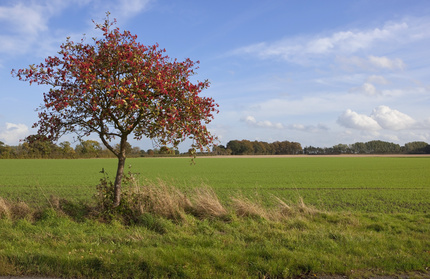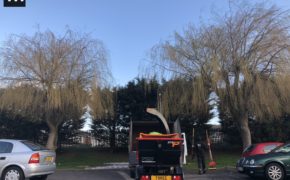
Get a quick no obligation quote It’s free and will only take a jiffy!
When is the Best Time for Whitebeam Pruning?
The whitebeam tree is a popular sight in parks and gardens thanks to its pretty white spring flowers followed by scarlet red berries, edible when ripe come early autumn. Whitebeam pruning is important to keep the tree looking its best. But when is the best time to do it, and what should you look out for during pruning?
The whitebeam tree, Sorbus aria, is a deciduous broadleaf tree native to the south of England and, thanks to its resilience and tolerance of most types of soil, is also planted extensively in the north of the country and can be found growing in various European countries including Spain, France and Germany.
Whitebeam isn’t known for its height, only growing to around 15 metres tall, but more for its scarlet coloured berries which are edible once they have almost perished come early autumn.
Whitebeam is also appreciated for its pretty white clustered flowers which appear in May, and its white, soft leaves that flutter in the breeze. A regular in parks and gardens, whitebeam is rarely seen in the wild.
Why is whitebeam pruning important?
Whitebeam is a fairly compact tree by nature and tends to look after itself for the most part. Because it doesn’t produce vigorous shoots, there is little need for a regular, formal pruning plan and in fact you’ll usually find that hard pruning has more of a negative effect.
It is however important to regularly remove any damaged, diseased, congested or crossing shoots in order to promote the good health of the tree. You may sometimes see shoots growing in an unruly fashion that are not in-keeping with the overall neatness of the whitebeam tree. These can be removed, providing care is taken over the timing (see below) as the whitebeam is prone to aphids and blister mites which are attracted by bleeding sap.
When is the best time for whitebeam pruning?
The best time for whitebeam pruning is late winter or early spring during its dormant period. Anything outside of this period is likely to result in sap bleeding which will attract insects and, in turn, disease and bacteria.
What to look for during whitebeam pruning
Whitebeam is prone to aphids. Also known as greenfly, blackfly or plant lice, aphids are small insects that suck sap from a plant. This can lead to loss of vigour for the tree as well as poor, distorted growth patterns. In addition, the honeydew secreted by the insects will often permit the growth of sooty moulds. Some aphids are known to pass around plant viruses which can cause issues for a number of plants. They tend to become active in spring and stay around until late summer.
Blister mites can also be a problem for this tree and is something to look out for during whitebeam pruning. Look out for raised red-pink or yellow-green blotches which eventually turn black on the leaves during spring and summer. The blisters are usually around 3-4mm in diameter so quite small and infestations will often lead to all the leaves of a tree becoming blackened. The health of the tree however is not usually affected, just its aesthetic appearance.
Tree Preservation Orders
Sometimes trees of particular interest or notability are protected by a Tree Preservation Order (TPO). Where this is the case, you will find that the level of pruning allowed for the particular protected tree will be restricted and that you will need to obtain permission to carry out works of any kind. You should always contact the arboriculture department of your local council to check the TPO register before starting any planned works. If you do need permission, bear in mind that this may take up to eight weeks to come through. Furthermore, where a tree is situated in a conservation area, you will need official permission before proceeding with works of any kind.
The importance of whitebeam pruning expertise
Whitebeam is one of the most attractive trees you’ll find in parks and gardens. It is important to ensure great care is taken to keep it looking at its best and to make sure it is healthy year-round. If you are in any doubt, the best thing to do is call in a professionally qualified tree surgeon.
When choosing a tree surgeon, be sure to check their references and certificates for complete reassurance. Also, where possible, select a tree surgeon with Trading Standards and local authority approval for a guarantee of quality and value.
If you have a whitebeam tree that needs pruning or care, why not contact the specialists at T.H. Tree Services? As fully qualified, locally renowned and long term experienced Trading Standards and local authority approved tree surgeons, we are well placed to offer expert knowledge in all aspects of whitebeam pruning. For a free, no-obligation quotation, call 01268 642814 or get in touch here.
Amazing service from Mark and his team. We had a problem with Bamboo that had spread from a neighbours garden. Mark kept us informed with regular phone calls and images of how the work was progressing, as we were not present the house. 1st class job and a pleasure to do business with this company.
Thank you Colin and Gillian for your kind review. It was a pleasure to be able to clear the bamboo for you.








